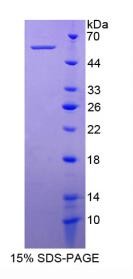轴突生长诱向因子4(Ntn4)重组蛋白
产品名称: 轴突生长诱向因子4(Ntn4)重组蛋白
英文名称: Recombinant Netrin 4 (Ntn4)
产品编号: YB835Hu012
产品价格: 0
产品产地: 中国/美国
品牌商标: 钰博生物/Ybscience
更新时间: 2023-08-17T10:29:50
使用范围: null
- 联系人 : 陈环环
- 地址 : 上海市沪闵路6088号龙之梦大厦8楼806室
- 邮编 : 200612
- 所在区域 : 上海
- 电话 : 183****2235
- 传真 : 021-60514606
- 邮箱 : shybio@126.com
轴突生长诱向因子4(Ntn4)重组蛋白
YB835Hu012
Recombinant Netrin 4 (Ntn4)
Organism Species: Homo sapiens (Human)
Instruction manual
FOR IN VITRO USE AND RESEARCH USE ONLY
NOT FOR USE IN CLINICAL DIAGNOSTIC PROCEDURES
10th Edition (Revised in Jan, 2014)
[ PROPERTIES ]
Residues: Glu349~His592
Tags: Two N-terminal Tags, His-tag and GST-tag
轴突生长诱向因子4(Ntn4)重组蛋白Accession: Q9HB63
Host: E. coli
Subcellular Location: Secreted, extracellular
space, extracellular matrix.
Purity: >95%
Endotoxin Level: <1.0EU per 1μg
(determined by the LAL method).
Formulation: Supplied as lyophilized form in 20mM Tris,
500mM NaCl, pH8.0, containing 1mM EDTA, 1mM DTT,
0.01% sarcosyl, 5% trehalose, and preservative.
Predicted isoelectric point: 7.0
Predicted Molecular Mass: 59.3kDa
Applications: SDS-PAGE; WB; ELISA; IP.
(May be suitable for use in other assays to be determined by the end user.)
轴突生长诱向因子4(Ntn4)重组蛋白[ USAGE ]
Reconstitute in ddH2O.
[ STORAGE AND STABILITY ]
Storage: Avoid repeated freeze/thaw cycles.
Store at 2-8oC for one month.
Aliquot and store at -80oC for 12 months.
Stability Test: The thermal stability is described by the loss rate of the target
protein. The loss rate was determined by accelerated thermal degradation test,
that is, incubate the protein at 37oC for 48h, and no obvious degradation and
precipitation were observed. (Referring from China Biological Products Standard,
which was calculated by the Arrhenius equation.) The loss of this protein is less
than 5% within the expiration date under appropriate storage condition.
轴突生长诱向因子4(Ntn4)重组蛋白[ SEQUENCES ]
The sequence of the target protein is listed below.
EA SGNRSGGVCD DCQHNTEGQY CQRCKPGFYR DLRRPFSAPD ACKPCSCHPV
GSAVLPA NSV TFCDPSNGDC PCKPGVAGRR CDRCMVGYWG FGDYGCRPCD
CAGSCDPITG DCISSHTDID WYHEVPDFRP VHNKSEPAWE WEDAQGFSAL LHSGKCECKE
QTLGNAKAFC GMKYSYVLKI KILSAHDKGT HVEVNVKIKK VLKSTKLKIF RGKRTLYPES
WTDRGCTCPI LNPGLEYLVA GH
[ REFERENCES ]
1. Koch M., et al. (2000) J. Cell Biol. 151:221-234. 2. Lejmi E., et al. (2008) Proc. Natl. Acad. Sci. U.S.A. 105:12491-12496. 3. Nacht M., et al. (2009) Exp. Cell Res. 315:784-794. 4. Larrieu-Lahargue F., et al. (2010) Blood 115:5418-5426.
